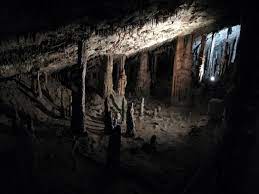The sequential development of landforms in a Karst region typically follows the following stages:
- Initial topography: The initial topography in a Karst region is typically characterized by flat-lying, homogenous beds of soluble rock such as limestone or dolomite.
- Underground drainage: As precipitation infiltrates into the soluble rock, it dissolves it and creates a network of underground drainage channels. This marks the beginning of the karstification process.
- Sinkholes: Over time, the roof of the underground drainage channels collapses, creating sinkholes. These sinkholes become increasingly common as the network of drainage channels continues to expand.
- Caves: As underground drainage channels continue to enlarge, caves form. Some of these caves may become large enough to be accessible to humans.
- Solution valleys: The continued enlargement of the underground drainage channels can result in the formation of large, deep valleys known as solution valleys. These valleys are characterized by steep walls and a flat bottom.
- Tower karst: In areas with particularly deep solution valleys, the remaining blocks of soluble rock can eventually be worn away, leaving behind isolated towers of rock known as tower karst.
- Doline karst: Over time, the continued collapse of the roof of the underground drainage channels can result in the formation of large, circular depressions known as dolines.
- Perennial streams: Finally, the enlarged underground drainage channels can intersect with the land surface, forming perennial streams. These streams are typically characterized by clear water and significant vertical drops.

This is a general overview of the sequential development of landforms in a Karst region, and the specifics of the process can vary depending on a number of factors, including the type of rock, the climate, and the rate of precipitation.